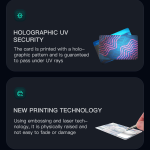The Real ID is an important form of identification in the United States. It was established in response to the 9/11 Commission Act to enhance security and standardize identification requirements for accessing certain federal facilities and boarding domestic flights. If you hold a self – sponsored visa and wish to obtain a Real ID, there are specific steps and requirements to follow.
Understanding the Real ID
A Real ID is a driver’s license or identification card that meets the minimum security standards set by the federal government. It has a special symbol, usually a star, on the card to indicate its compliance. This symbol is important as it signals to authorities that the cardholder has provided the necessary documentation to prove their identity, legal status, and residency.
Real IDs are required for various purposes such as boarding domestic flights starting from a specific deadline (which may be subject to change), entering certain federal buildings, and accessing some military bases. Without a Real ID, you may need to present additional forms of identification, like a passport, for these activities.

Self – Sponsored Visa Basics
A self – sponsored visa is a type of visa where the applicant is not being sponsored by an employer, family member, or other entity. This could include certain types of business visas, investor visas, or some types of immigrant visas where the applicant has the financial means and meets the criteria to apply on their own. The self – sponsored visa indicates your legal status in the United States and is an important document when it comes to various administrative processes, including applying for a Real ID.
The Application Process for a Real ID with a Self – Sponsored Visa
- Check Eligibility: First, ensure that you are eligible to apply for a Real ID. In addition to having a valid self – sponsored visa, you must also meet other state – specific requirements. These may include proof of identity, residency, and Social Security number (if applicable). For example, some states may require you to have lived in the state for a certain period of time before being eligible to apply for a Real ID.
- Gather Required Documents:
- Identity Documents: You will need to present an original or certified copy of a document that proves your identity. This could be a valid passport, a birth certificate (original or certified copy), or a foreign government – issued identification document with a photo. If you are a non – U.S. citizen, your self – sponsored visa document is also crucial as it shows your legal status in the country.
- Residency Documents: To prove your residency in the state where you are applying for the Real ID, you can provide documents such as utility bills (electricity, water, gas), lease agreements, or bank statements with your name and current address. Make sure the documents are recent, usually within the last few months.
- Social Security Number Documentation: If you have a Social Security number, you may need to provide documentation such as a Social Security card. In some cases, if you are not eligible for a Social Security number (e.g., due to your visa type), you may need to provide a letter from the Social Security Administration stating that you are not eligible.
- Visit the DMV: Once you have all the required documents, make an appointment or visit your local Department of Motor Vehicles (DMV) office. Some states may require appointments for Real ID applications, while others may accept walk – ins. It’s a good idea to check the DMV’s website or call ahead to find out their specific procedures.
- Complete the Application Form: At the DMV, you will be provided with an application form for the Real ID. Fill out the form accurately, providing all the required information such as your name, date of birth, address, and visa details. Make sure to double – check for any errors before submitting the form.
- Pay the Fee: There is usually a fee associated with applying for a Real ID. The amount may vary by state. Acceptable forms of payment typically include cash, credit cards, or debit cards. Be prepared to pay the fee at the time of application.
- Provide Biometric Information: You will likely be required to provide biometric information such as a photo and fingerprints. The photo will be used on your Real ID card, and the fingerprints are for security and identification purposes. Follow the instructions of the DMV staff during this process.
- Wait for Processing: After you have submitted your application, paid the fee, and provided the necessary biometric information, the DMV will process your application. The processing time can vary, but it may take several weeks. You may be able to check the status of your application online through the DMV’s website or by contacting their customer service.
- Receive Your Real ID: Once your application has been approved, you will receive your Real ID in the mail or be able to pick it up at the DMV, depending on the state’s procedures. Make sure to check the information on the card for accuracy as soon as you receive it.
Common Problems and Solutions
Problem 1: Incomplete or Incorrect Documentation
One of the most common issues applicants face is having incomplete or incorrect documentation. For example, the residency document may not have the correct address or may be an expired document.
Solution: Carefully review the list of required documents well in advance of your application. Make sure all documents are up – to – date, have the correct information, and meet the DMV’s requirements. If you are unsure about a particular document, contact the DMV or consult an immigration attorney for clarification.

Problem 2: Difficulty in Proving Residency
Some applicants, especially those who have recently moved or have unique living situations, may have trouble providing sufficient proof of residency. For instance, if you are living with a friend or family member and don’t have a lease in your name, it can be challenging to prove your address.
Solution: In such cases, you can try to obtain a letter from the property owner or landlord stating your occupancy. Additionally, you can provide other supporting documents such as mail addressed to your current address, or utility bills that are in your name and reflect the address. You may also consider getting a notarized affidavit from a third – party who can verify your residency at the given address.
Problem 3: Language Barriers
For non – English speaking applicants with self – sponsored visas, understanding the application process and the requirements can be difficult due to language barriers. This may lead to misunderstandings and mistakes during the application.
Solution: Many DMV offices offer language assistance services. You can call ahead to inquire about interpreters or translation services. Some states also provide application forms and instructions in multiple languages. You can also bring a friend or family member who is fluent in English to assist you during the application process. Additionally, there are online resources available in different languages that can help you understand the Real ID application requirements.
Problem 4: Delays in Processing
Sometimes, the processing time for a Real ID application may be longer than expected. This could be due to a high volume of applications, issues with the submitted documents, or other administrative factors.
Solution: If you are experiencing a delay, first check the status of your application online or by contacting the DMV’s customer service. If there are issues with your documents, the DMV should notify you of what needs to be corrected. You can also consider following up in person at the DMV office if necessary. It’s important to plan ahead and apply for your Real ID well in advance of any travel or activities that require it to avoid last – minute stress.
Problem 5: Issues with Social Security Number Documentation
Some self – sponsored visa holders may face problems related to Social Security number documentation. For example, if you have lost your Social Security card or are unsure about your eligibility for a Social Security number based on your visa type, it can complicate the Real ID application.
Solution: If you have lost your Social Security card, you can apply for a replacement through the Social Security Administration. If you are unsure about your eligibility for a Social Security number, contact the Social Security Administration directly or consult an immigration attorney. They can provide you with the necessary guidance and help you obtain the appropriate documentation, such as a letter stating your ineligibility if applicable, for the Real ID application.
Fake ID Pricing
unit price: $109
| Order Quantity | Price Per Card |
|---|---|
| 2-3 | $89 |
| 4-9 | $69 |
| 10+ | $66 |


